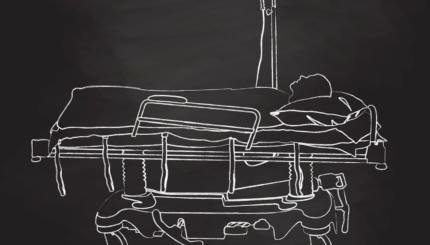Judaism encourages us to both acknowledge our mortality and embrace the sacredness and import of life on earth. Jewish teachings on what awaits the soul (and the body) after death–and in a hoped-for World to Come–are quite varied and therefore this realm remains somewhat mysterious, contributing to Judaism’s focus on this world and what can be done in a lifetime.
Death–an end to a human life–is seen as both tragic and inevitable; knowing that death must come, Jewish teachers over the ages have modeled the need to face death squarely and the hope that a life well-lived will be rewarded with eternal life. While each death is in some sense a tragedy, to some thinkers it also represents a kind of homecoming.
A corpse–in the words of one writer, “the vehicle of the soul while the deceased was still alive on earth”–must be treated with great dignity and care. Many laws and customs have developed over the years regarding the care of the body of the deceased, from the moment of death continuing through the burial.
 Many contemporary Jews know little about Jewish practices surrounding death and mourning; Jewishly unprepared for death, they can be denied the meaning of ritual at this important time and the opportunity for consolation through ancient traditions. Those who are familiar with the rites of mourning–especially as more and more people find themselves present at the moment of death–know what initial steps to take to preserve the dignity of the deceased and help ease the pain of their own loss. For many who feel “lost” upon witnessing or learning of the death of a loved one, these time-honored practices can bring comfort.
Many contemporary Jews know little about Jewish practices surrounding death and mourning; Jewishly unprepared for death, they can be denied the meaning of ritual at this important time and the opportunity for consolation through ancient traditions. Those who are familiar with the rites of mourning–especially as more and more people find themselves present at the moment of death–know what initial steps to take to preserve the dignity of the deceased and help ease the pain of their own loss. For many who feel “lost” upon witnessing or learning of the death of a loved one, these time-honored practices can bring comfort.

Help us keep Jewish knowledge accessible to millions of people around the world.
Your donation to My Jewish Learning fuels endless journeys of Jewish discovery. With your help, My Jewish Learning can continue to provide nonstop opportunities for learning, connection and growth.
A few overarching themes emerge from a review of the specific and details laws of death and mourning, including these:
· We are commanded to “choose life,” and extend life where it is possible and dignified to do so. But we must also be prepared to let go when the time for death has come.
· Similarly, mourning is to be encouraged–but excessive mourning is discouraged.
· Rich and poor, male and female, are equal in death and mourning.
· The dignity of the deceased is paramount.
· Caring for the dead and comforting mourners are sacred tasks, allowing us to do no less than imitate God.
· Mourning customs have evolved over time, including those that have no particular basis in Jewish law but can be very powerful for mourners–for example, the practice of covering the mirrors in a house of mourning.
· Ancient rituals and prayers, even those that present a theology not identical to one’s own, are nevertheless often very powerful for those in mourning.
The austerity of traditional burial practices and its attendant democratic approach deserves special note. The Talmud explains that the inability to provide what would appear in one’s community to be “a proper burial” too often led poor families in the ancient world to abandon their dead, or at very least to suffer great embarrassment at their inability to do right by the family member they had lost. In response, the great sage Rabban Gamliel ordered that he be dressed in simple linen cloth when the time came for his own funeral. This soon became the communal norm, as did the practice of a plain, simple casket. In a similar vein, charitable contributions are encouraged instead of flowers to honor the dead, so that the funds might benefit those in need rather than enhance the funeral aesthetically.
Liberal Jews may view halakhah (Jewish law and its attendant traditions) as “guide rather than mandate,” often asking questions not generally anticipated by Jewish law. These include whether or not a full week of shiva will be observed, how to mourn for a non-Jewish relative, and how to mourn a beloved friend or companion to whom one is not technically related.
The various conclusions they reach, sometimes but not always with the assistance of a rabbi, reflect a diversity of individual needs and–increasingly–an interest in engaging with traditional mourning practices, even in non-traditional ways. For example, a liberal Jew mourning the death of a non-Jewish spouse may ask his or her rabbi to read a passage from Psalms at the non-denominational funeral and have a minyan [quorum for prayer] of Jewish friends present the burial so that Kaddish might be recited. Or, a mourner may observe only three full days of shiva (reflecting the traditional emphasis on these days as more intensive than the latter four) and then return to work, but ask that friends continue to visit for the next several evenings.
Sign up for a Journey Through Grief & Mourning: Whether you have lost a loved one recently or just want to learn the basics of Jewish mourning rituals, this 8-part email series will guide you through everything you need to know and help you feel supported and comforted at a difficult time.
Looking for a way to say Mourner’s Kaddish in a minyan? My Jewish Learning’s daily online minyan gives mourners and others an opportunity to say Kaddish in community and learn from leading rabbis.
minyan
Pronounced: MIN-yun, meen-YAHN, Origin: Hebrew, quorum of 10 adult Jews (traditionally Jewish men) necessary for reciting many prayers.

Help us keep Jewish knowledge accessible to millions of people around the world.
Your donation to My Jewish Learning fuels endless journeys of Jewish discovery. With your help, My Jewish Learning can continue to provide nonstop opportunities for learning, connection and growth.
shiva
Pronounced: SHI-vuh (short i), Origin: Hebrew, seven days of mourning after a funeral, when the mourner stays at home and observes various rituals.

Help us keep Jewish knowledge accessible to millions of people around the world.
Your donation to My Jewish Learning fuels endless journeys of Jewish discovery. With your help, My Jewish Learning can continue to provide nonstop opportunities for learning, connection and growth.
Talmud
Pronounced: TALL-mud, Origin: Hebrew, the set of teachings and commentaries on the Torah that form the basis for Jewish law. Comprised of the Mishnah and the Gemara, it contains the opinions of thousands of rabbis from different periods in Jewish history.

Help us keep Jewish knowledge accessible to millions of people around the world.
Your donation to My Jewish Learning fuels endless journeys of Jewish discovery. With your help, My Jewish Learning can continue to provide nonstop opportunities for learning, connection and growth.


